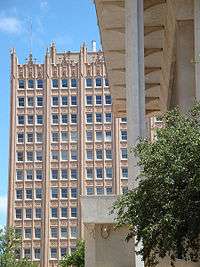Petroleum Building (Midland)
| T.S. Hogan Petroleum Building | |
|---|---|
|
T.S. Hogan Petroleum Building | |
| General information | |
| Status | Complete |
| Type | Office space |
| Location |
214 W. Texas Ave. Midland |
| Coordinates | 31°59′55″N 102°04′34″W / 31.998679°N 102.075988°WCoordinates: 31°59′55″N 102°04′34″W / 31.998679°N 102.075988°W |
| Construction started | 1928 |
| Completed | 1928 |
| Opening | 1929 |
| Height | |
| Antenna spire | 151 ft (46 m) |
| Roof | 137 ft (42 m) |
| Top floor | 12 |
| Technical details | |
| Floor count | 12 |
| Floor area | 5,788 sq ft (537.7 m2) |
| Lifts/elevators | 3 |
| Design and construction | |
| Architect | Wyatt C. Hendrick |
| Developer | T. S. Hogan |
| Designated | 1982[1] |
| Reference no. | 4002 |
The Petroleum Building (formerly known as the Hogan Building) is a highrise in downtown Midland, TX. The building was built in 1928 and consists of 12 floors and has a neo-gothic style architecture to it. The building stands at 137 ft but with its spires reaches a height of 151 ft. The Hogan building is a registered, Texas historical landmark. The tower is named for lawyer and oil entrepreneur Thomas Stephen Hogan. For information on Hogan, see article on Jacob Bunn. The design of the Petroleum Building, like the Woolworth Building in New York City and the Baum Building in Oklahoma City, utilizes many classic architectural devices. Gothic spires and Moorish arches, lavish carved surfaces and opulent marble, all intended to clothe the business house with the respectability of a cathedral. Thomas Stephen Hogan intended his building to be a landmark and (Fort Worth architect-engineer) Wyatt Hedrick designed a building that people would talk about. However, behind the ornate cast-stone façade was (sic) functional reinforced concrete, the finest equipment available, and the determination of one man to establish Midland as the headquarters of the West Texas oil fields.
References
- ↑ "Texas Historic Sites Atlas". Texas Historical Commission. Retrieved 17 March 2013.
